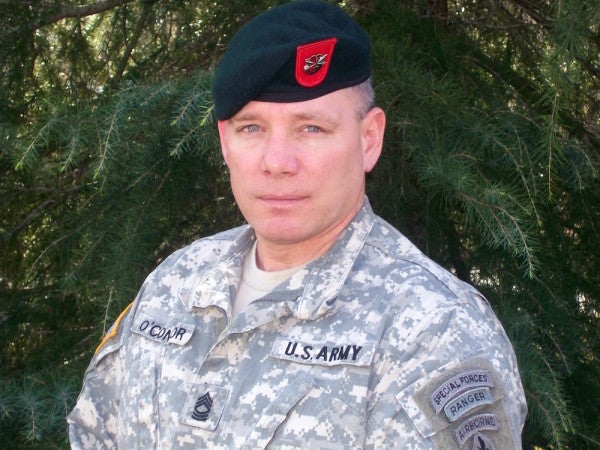UNSUNG HEROES: The Green Beret Who Crawled 90 Yards Under Heavy Fire To Save His Men
During a battle in Afghanistan that would last more than 17 hours, Sgt. 1st Class Brendan O’Connor crawled through a...

During a battle in Afghanistan that would last more than 17 hours, Sgt. 1st Class Brendan O’Connor crawled through a ditch to reach two wounded men, as machine gun fire from Taliban fighters cut the grass all around him. Taking control after the team leader was killed, O’Connor coordinated the safe extraction of his team by the use of infrared light beams from friendly aircraft and night-vision goggles.
On June 24, 2006, O’Connor’s Army Special Forces team, attached to a few dozen Afghan National Army soldiers, was on a kill-or-capture mission southwest of Kandahar when over 200 Taliban insurgents surrounded them.
“And it's like all hell breaks loose. Literally, all hell breaks loose,” Maj. Shef Ford, another Army Special Forces soldier with O’Connor’s team, told 60 Minutes. “The enemy is firing at all directions at us. And soldiers are trying to identify the positions and return fire. They had completely surrounded us and were firing at us with multiple systems.”
The Taliban force was large and well organized, employing tactics the Special Forces team did not expect. The U.S. and coalition forces had to get a sense of what was happening. Using an unmanned aerial drone, the team leader, Master Sgt. Thomas Maholic, led a few of the Green Berets to what appeared to be the Taliban command center near a cemetery. As they neared the location, the Taliban pulled back, but it was obvious to Maholic and his men that they had set up a dug-in machine gun position.
Taliban machine gun fire opened up as Staff Sgt. Matthew Binney, Staff Sgt. Joe Fuerst, and a translator separated to provide covering fire. The machine gun fire fractured Binney’s skull and shattered his shoulder, and a rocket-propelled grenade hit Fuerst in the chest, not exploding but providing enough blunt force trauma to critically wound him. Binney later found a bullet hole in his Camelbak water bladder, and six bullet holes in his pants, according to Army Times.
O’Connor knew he had to retrieve his comrades before they were killed, or worse, before they were captured. According to 60 Minutes, the team translator could hear the Taliban taunting him, telling him to keep the soldiers alive for capture and he would be forgiven. The translator went on the radio and said he could make sure none of them were captured alive, but O’Connor was on his way.
A 14-inch-deep ditch stretched across the field separating O’Connor from his injured brothers, according to Army Times. The elevation rise at the end of the ditch indicated to him that he’d have to make a run for it toward the end, but he began the dangerous low crawl to his men nonetheless.
As O’Connor crawled through the ditch, his body armor and pouches filled with dirt, raising his body off the ground, making the crawl all the more treacherous.
“I actually pulled back to cover, to a covered position and removed my body armor,” O'Connor recounted to 60 Minutes.
His teammates watched him crawl for an hour and a half in disbelief.
“They described to me watching the machine gun fire go right over his body, seeing it hit grass that he was crawling through and seeing it mow some of that down, the fires were so heavy it was literally cutting some of the grass in different spots,” Ford told 60 Minutes.
From the rooftop above, Maholic protected O’Connor in the rescue operation with covering fire as he finished the crawl, and carried the wounded to back safety. Without Maholic’s support, the Taliban could have overrun the location where Binney and Fuerst were trapped.
It was then that Maholic was struck by a bullet in the head, killing him. Fuerst also succumbed to his wounds as O’Connor carried him to what would’ve been safety. Binney was recovered, alive but in poor condition.
Maholic’s death left O’Connor in command. The men were not sure anyone would escape alive, and some even took small moments to write letters to loved ones.
AH-64 Apache gunships rained gunfire down on the Taliban, but they still surrounded O’Connor and his team. To escape, they had a pilot lead them to safety using an infrared beam only visible on night-vision goggles. O’Connor led his team 600 meters in the darkness, following only the beam while the gunships took out everything not following their infrared marker.
O’Connor received the Distinguished Service Cross April 30, 2008, at Fort Bragg, North Carolina, according to an Army press release.
Master Sgt. Brendan O'Connor, right, 7th Special Forces Group (A) Operational Detachment Alpha, was awarded the Distinguished Service Cross by Adm. Eric T. Olson, commander of United States Special Operations Command, during a ceremony at Bank Hall, Fort Bragg, N.C., April 30, 2008.Photo by Sgt. Daniel Love

“For the men who were with him that day, Master Sergeant O'Connor is a savior,” said Adm. Eric T. Olson, then commander of U.S. Special Operations Command, at the award ceremony.
“For all Americans, he is a hero, and for all members of special operations across the services, he is a source of enormous pride,” he said.
“I've never been more honored, but this medal belongs to my whole team,” said O'Connor. The Distinguished Service Cross is the second greatest commendation for valor in combat awarded to an Army soldier, preceding the Medal of Honor.
“Every member was watching out for the other, inspiring each other, and for some, sacrificing for each other,” he said. “We all fought hard, and it could just as easily be any one of them standing up here getting it pinned on; every one of them is a hero.”
Maholic, Ford, and another Green Beret in that battle, Sgt. 1st Class Abram Hernandez, were each awarded Silver Star medals for their courageous actions that day.